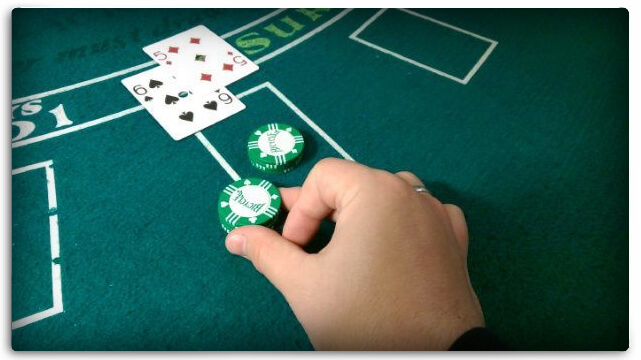Multiple Simultaneous Blackjack Hands (Pros and Cons)

Did you know that you can play more than one hand of blackjack at a time in most casinos?
If a table is full, this isn’t possible. But at most casinos, the blackjack tables aren’t quite full. I see a lot of my fellow gamblers playing two hands simultaneously. You’re not limited to just two hands either. You could even play three hands at the same time if you needed to.
Is this a good idea or not? A simple answer might be to think about what playing multiple hands does to your average win or loss rate.
If you’re a recreational player, even if you use basic strategy, playing multiple hands simultaneously just means you’ll lose more money faster. But if you’re an advantage blackjack player, playing multiple hands simultaneously will result in a higher average hourly win rate.
If you’re thinking about playing two hands at a time instead of just one, you should examine your reasoning for this rationally. If you think it’s just going to change your luck, you shouldn’t do it. The number of hands you’re playing doesn’t affect luck in any way because, after all, luck is just standard deviation.
The house edge will stay the same regardless of how many hands you’re playing.
What Playing Multiple Hands Does
Let’s look at a few different scenarios.
In the first scenario, you decide to play one hand at a time for $5 per hand. You’re using perfect basic strategy, and the house edge in this specific casino is only 0.4%. It’s a two-deck game with good rules. It’s also the middle of the afternoon, and the casino isn’t busy, so you’re playing heads up against the dealer. This means you’re getting in 200 hands per hour.
The amount you’re mathematically expected to lose in this scenario is easy to calculate. You multiply the number of bets you’re making per hour (200) by their size ($5) to get your total amount of hourly action.
In this case, you’re putting $1000 into action per hour. The house edge is the amount the casino expects to win in the long run, so you multiply the house edge by the action. That gives you an expected hourly loss of $4.

Now, let’s take a second scenario. It’s the same table, same rules, same amount per hand, and same perfect strategy on your part.
But because you’re playing two hands per hour, the game slows down a little bit to 160 hands per hour, but multiplied by 2, since you’re playing both of them.
Now, you’re getting in 320 hands per hour, which means your hourly action jumps to $1600. 0.4% of $1600 is $6.40 per hour in expected losses. It’s obvious that you’re going to lose more money playing two hands per hour.
Also, the more hands you get in, the closer your actual results will get to the mathematically expected results. In other words, if you’re hoping to capitalize on a short-term lucky streak, you reduce the probability of doing that by playing so many hands.
Now, let’s look at a third scenario. You’re playing the same game, but you’re counting cards, and you have a 0.4% edge over the house instead of playing against a house edge of 0.4%.
Instead of an expected loss per hour of $4, you now have an expected win per hour of $4. AND if you play two hands instead of one, you have an expected win per hour of $6.40.
Since you’re counting cards, you get more information faster by seeing more cards per hand, too. The more cards you see, the more accurate your count becomes.
One More Example of Playing Multiple Blackjack Hands at Once
I want to look at one more scenario. This time, instead of playing for $5 per hand, you have a player who’s
betting $100 per hand.
That’s 200 hands per hour at $100 per hand, or $20,000 in hourly action. 0.4% of that is $80 in expected losses per hour.
What if this player decides to start playing two hands at a time instead of just one, and he only bets $50 per hand? He’s still putting $100 “per round” into action, but the action slows down because of the extra hands.
Instead of 200 bets per hour at $100, he’s getting in 320 bets per hour in at $50 per hand, or $16,000 in hourly action. His hourly expected loss goes down to $64 instead of $80.
If this player were counting cards with an edge of 0.4%, his hourly win rate would drop correspondingly. This seems counterintuitive, but if you think about it, this is the case.
Some Conclusions to Draw From All this Math
The first conclusion is that if you’re not changing the size of your bets, but you’re making almost twice as many bets per hour, you’ll lose (or win) more money based on your mathematical expectation. Average players will lose more per hour, and advantage players will win more per hour.
But if you reduce the size of your bets AND reduce the number of hands you’re getting per hour, you’ll lose (or win) more money, again based on your mathematical expectation.
Most of my readers are basic blackjack strategy players. This means that, over time, they’re going to see a net loss. But that net loss is lower than you’d see at almost any game in the casino.
My hope for that player would be that they’d realize the importance of getting in fewer hands per hour. The fewer hands you play per hour, the less money you’ll lose on average over time.
Playing two hands at once is one way to get in fewer hands per hour, but it’s not the only way. You could also limit your play to tables with a minimum number of players.
If you stick with games where there were at least four other players at the table, you’d only play 70 hands per hour instead of 200 or 160. You could afford to bet more per hand and still lose less money per hour at such a table.
And if you stick with your other betting amounts, you’d save a lot of money and have a lot of fun socializing while you’re at it.
Conclusion
The pros of playing multiple hands of blackjack at the same time are simple enough.
- If you have an edge over the casino, you can make more money per hour doing this.
- If you don’t, you can put the same amount of money into play per round by playing two hands instead of one and betting half the amount. This will reduce your hourly expected loss rate.
The cons of playing multiple hands of blackjack are simple enough, too.
- You’re less likely to see a lucky winning streak based on short term variance.
- You’re going to lose more money per hour if you don’t reduce your bet size, because you’ll be getting in more hands per hour for the same amount per hand.
Should you play multiple hands of blackjack simultaneously? That depends on all the factors discussed above.
Are you a card counter? Do you think you’ll try to earn more by playing two hands at a time after reading this? Are you a basic strategy player? Do you think you’ll try to get in less action per hour to try to reduce your hourly loss rate?
Let me know in the comments.

 Author:
Author: 